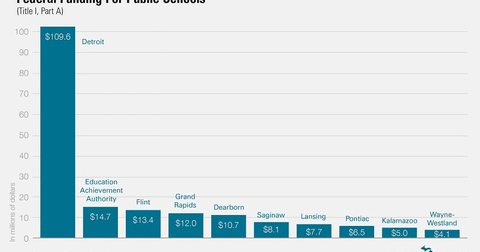Federal Funding Favors Poorer School Districts Like Detroit
Schools get money from different pots
While Detroit Public Schools and 15 of its schools now under a form of state receivership accounted for 3.5 percent of the state’s student population in 2014-15, they claimed 26 percent of the federal money sent to Michigan schools in the largest grant program for children in poverty.
Most federal money to schools is targeted at helping meet the needs of children from low-income backgrounds. And sometimes lost in the ongoing debate over school funding is how much poor communities benefit from federal money compared with wealthier ones.
Rick Joseph, the Michigan Teacher of the Year, wrote a column this month in Bridge Magazine in which he alleged a funding gap between “debt-ridden urban and rural areas and affluent suburbs.” Joseph teaches at Birmingham, an affluent suburb.
Under Michigan’s complicated school funding distribution formula, all districts get a minimum per-pupil foundation allowance, with state tax dollars filling in for lower local property taxes in poorer school districts. The foundation allowance makes up as much as 85 percent of the money a school district receives from the state. Districts in a small number of wealthy communities that had high local school taxes and spending before the current system went into effect in 1994 continue to receive higher allowances.
Birmingham had an $11,854 per pupil foundation allowance in the 2014-15 school year. Detroit’s was $7,296 per pupil. But there was another large source of school funding that was tilted the other direction.
Detroit received $3,589 per student from the federal government last year for general operations while Birmingham got just $292 per student. This is what one should expect given that federal money is distributed largely on the basis of how many students come from low-income backgrounds, as demonstrated by eligibility for free lunches. Just 7.6 percent of Birmingham students met that test, but 75 percent of Detroit students qualified.
Total federal funding for DPS in 2014-2015 was $169.3 million, which accounted for 25 percent of the Detroit district’s operations budget. Birmingham received a total of $2.4 million in federal money that year.
Detroit Public Schools teachers who supported recent sickout strikes clamored for a level playing field for Detroit students. In terms of federal dollars, the playing field does favor districts with more students in poorer families. This money comes from several pots.
For example, in 2014-15, the federal government awarded $486.9 million to Michigan in the form of Title I-Part A funding. Detroit Public Schools, which had 47,595 students that year, received $109.6 million of that money. Schools under the state’s Educational Achievement Authority receivership (6,556 enrollment) were awarded $14.7 million. The next largest federal share went to Grand Rapids, with an enrollment of 16,546 students. It received $12.0 million.
Detroit also does well in overall funding. In the 2014-15 school year, the district collected $13,743 per pupil from all sources. The statewide average was $9,457.
“Too often people focus on the state foundation allowance as if it is the only source of education funding,” said Gary Naeyaert, the executive director of the Great Lakes Education Project. “The reality is that federal funds targeted for at-risk students level the playing field considerably. It makes more sense to look at total funding than any one funding stream.”
Michigan Capitol Confidential is the news source produced by the Mackinac Center for Public Policy. Michigan Capitol Confidential reports with a free-market news perspective.


 Detroit teachers have an attendance problem
Detroit teachers have an attendance problem
 Growing Michigan Together Council says more education spending will draw people to state
Growing Michigan Together Council says more education spending will draw people to state